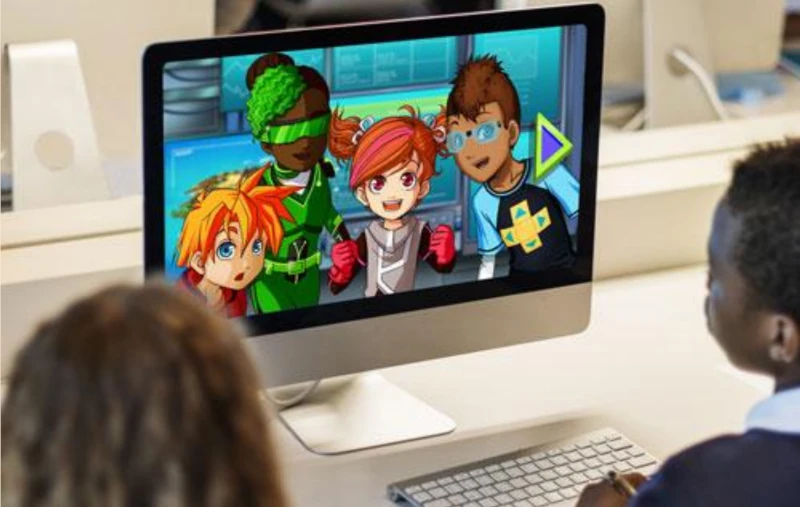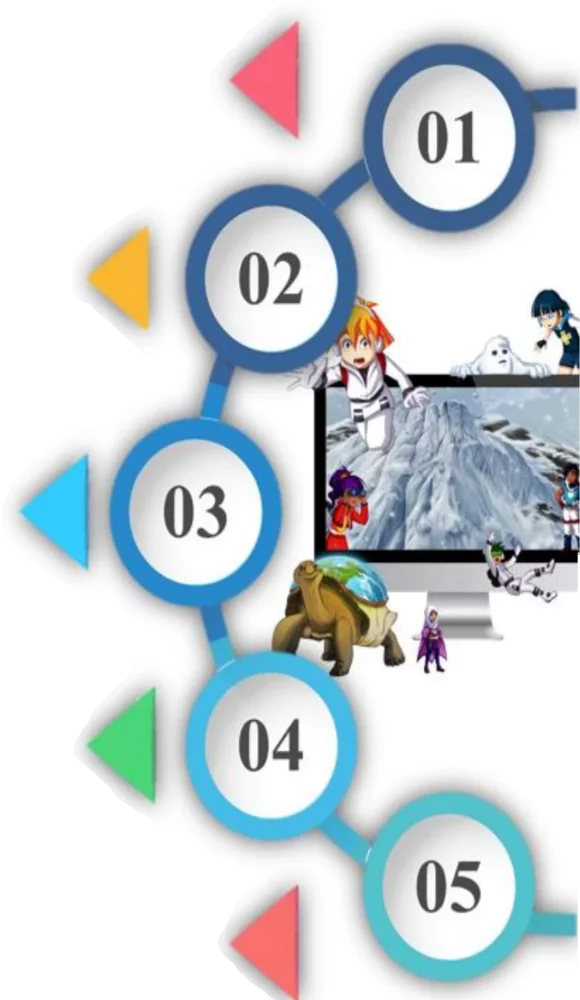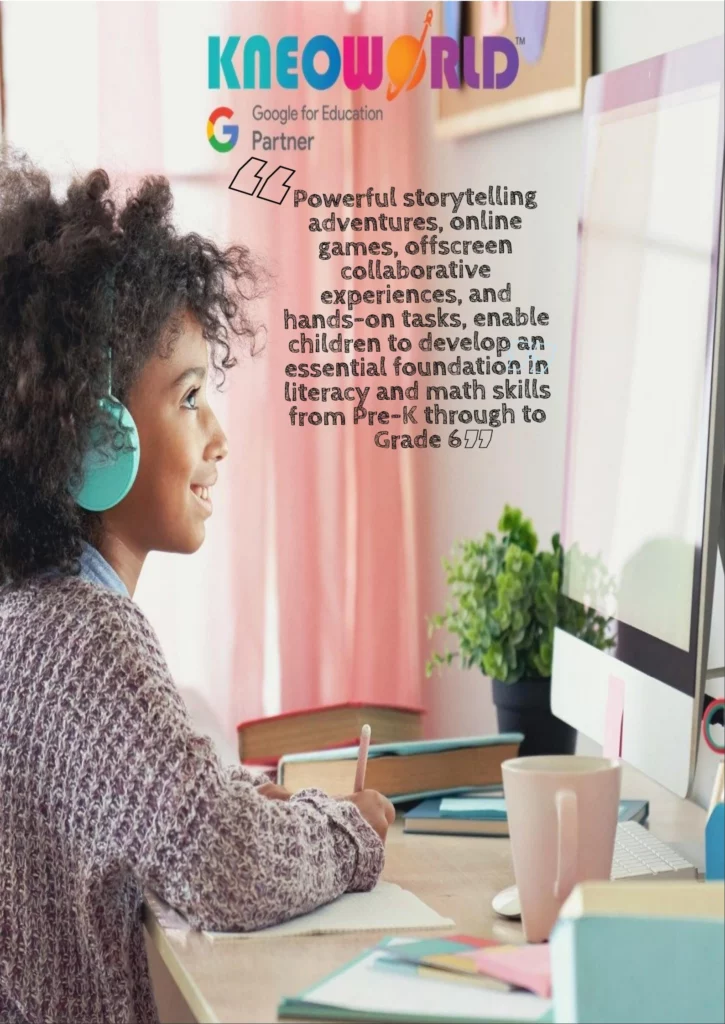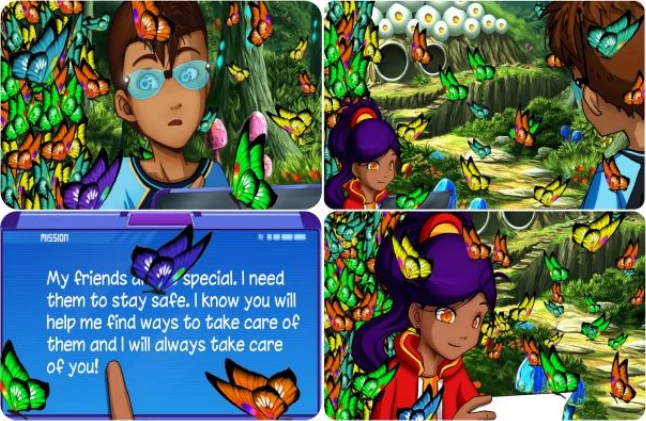International Journal of Latest Research in Humanities and Social Science (IJLRHSS)
Volume 05 – Issue 07, 2022
www.ijlrhss.com || PP. 25-32
Learning by playing through KneoWorld's teaching method1
Deyby Espinosa
Educational researcher KneoWorld
https://orcid.org/0000-0003-1888-8282
Di Kellett
Marketing Director
Damian O'Sullivan
Chief Operations Officer
María Leandri
KneoWorld Inc
Denine Jimmerson
Educational researcher KneoWorld
Abstract: Play can be considered as one of the most important pedagogical strategies in the teachinglearning process, especially in the infant stage. For this reason, the KneoWorld educational programme considers play as a necessary pedagogical practice in the teaching-learning process, as it stimulates
learning, memory and creativity in an easy way. In addition, this strategy promotes reading, mathematics, STEM, social and emotional learning from Pre-Kindergarten to sixth grade in the USA and around the world.
This article recounts the educational experience, benefits and competencies achieved by the KneoWorld Programme through the implementation of play as a pedagogical strategy in children’s learning.
Keywords: The game, KneoWorld Educational Programme, Learning, Story-based learning
The importance of play: Learning by doing.
“Play is a self-forming activity of the child’s personality”.
Jean Piaget
According to UNICEF (2018) scientific research over the last 30 years shows that the most important period of human development is from birth to eight years of age. During these years, the development of learning, cognitive skills, emotional well-being, social competence and good mental health form a solid basis for life in society.
That is why the KneoWorld Education programme considers play to be so important during this age range and during the entire teaching-learning process. For KneoWorld, play is an activity that enhances all learning, promotes creativity, fun, reflection, criticism, problem solving, psychosocial and communicative development. Through play, children practise the knowledge they progressively acquire during classes. The game becomes a relationship between theory and practice, an opportunity to promote problem solving and recognition of reality.
Play is synonymous with curiosity. It finds theoretical and practical support from various philosophical, pedagogical, sociological and pedagogical perspectives, in this sense, we can point to the philosopher and psychologist Karl Groos (1902) as the pioneer in investigating the role of play as a phenomenon of development of thought and activity; for this philosopher, play is configured in an exercise of functions necessary for adult life, as it contributes to the stimulation and development of functions and capacities that prepare the child to be able to perform the activities that he or she will carry out when he or she grows up.
For the famous Swiss psychologist Jean Piaget (1967), play is part of the child’s intelligence, as it represents the functional or reproductive assimilation of reality according to each individual’s evolutionary stage. Piaget speaks of four stages of cognitive development: the first is the sensory-motor stage (0-2 years), which consists of learning through the senses and interaction with objects. The second stage is the preoperational stage (2-7 years), in which symbolic function, oral and written language are developed. The third stage is that of concrete operations (7-11 years) during which simple mental operations such as reversibility are stimulated, and finally, the fourth stage is that of formal operations (11 years – adulthood), which consists of the development and strengthening of logical, abstract, inductive and deductive thinking. Piaget’s theory thus places action and self-directed problem solving squarely at the centre of learning and development. Through action, logic and rationality are enhanced through play.
One of the most prominent theorists of developmental psychology, Vigotsky, considered that play arises as a need to reproduce contact with others. Nature, origin and background of play are social phenomena, and through play scenes are presented that go beyond individual instincts and inner drives. Thus, for this Russian philosopher, play is a social activity in which, thanks to cooperation with other children, it is possible to acquire roles or roles that are complementary to one’s own. For Vigotsky, play is symbolic and he points out how through play the child transforms some objects and converts them in his imagination into other meanings, for example, when he runs with the broom as if it were a horse, and with this handling of things he contributes to
the child’s symbolic capacity.
Among others, for Torbert and Schnieder (1986) play is “the key that opens many doors”. Erickson states that play is “a hectic process of the child’s life”; White summarised it as “a diversion, but also as a serious process. During these hours the child firmly structures his aptitude in relations with the environment”; and for the psycho-pedagogist Francesco Tonucci, children learn much more by playing than by studying, by doing than by watching. The play they do on their own without adult control is the highest cultural form a child touches.
Despite the conceptual precisions of different theorists, they all agree on the importance of play in the psychological, pedagogical and social aspects of human beings (Cuellar, Tenreyro and Castellón, 2018).
It can be pointed out that play has a universal character, i.e. people from all cultures have always played. Many games are repeated in most societies. It is present in human history despite the difficulties in some eras to play, such as in early industrial societies.
A very curious learning method
Education demands a constant transformation in the way we teach and learn. It is undeniable that global education is increasingly focused on the pursuit of excellent results and competencies. It focuses on numbers rather than on the human, which leads to an education prioritised on the development of guides, formats, standardised tests and more tests. This type of education tends to relegate from the classroom the time for listening, dialogue with students, reading the context and play, the latter is often wasted in education, and with it, the multiple pedagogical potential it has in learning as we will see throughout this article.

For this reason KneoWorld implements a very curious teaching method, as it understands the need to transform and innovate the way of teaching reading, writing, mathematics, social and emotional learning through play, allowing other more dynamic, creative and easy ways of learning.
How does the game work with KneoWorld?
– They learn by doing. Through the educational platform, students discover and learn through trial and error. They use competences and problem-solving skills. KneoWorld teacher-mediated process.
– They set a plan and follow it. Each story and game is pedagogically designed to strengthen reading, maths and social-emotional skills. Involves student action.
– They reason logically and analytically. Each time the adventure progresses, learning becomes more complex, which implies a greater demand in the understanding of the problems and their resolution.
– Communication. Games and stories encourage dialogue with peers, teachers and families.
What is the KneoWorld method?
 ?
? Inclusive
Through the adventures and stories we learn to recognise and value human diversity, respect human differences and care for our environment.
Fun
At KneoWorld we want learning to be a feeling of excitement, enjoyment and pleasure for our students. Students smile, play and learn, and this certainly stimulates memory easily.
Interactive
The games and stories designed by the pedagogical team allow students to express their ideas and recognise the ideas of others. Through play, social and family interaction is promoted.
Participative
At KneoWorld we understand that learning is constantly changing. Students participate freely, practise skills, test possibilities, reflecton problema situations and search for meaningful solutions.
Discovering
Through a cast of animated characters (Kneo Explorers) students become explorers of knowledge. Each adventure is combined with reading, maths, social studies, science and critical thinking.
Why is it important to play in
 ?
?

Inclusive
Through the adventures and stories we learn to recognise and value human diversity, respect human differences and care for our environment.
Fun
At KneoWorld we want learning to be a feeling of excitement, enjoyment and pleasure for our students. Students smile, play and learn, and this certainly stimulates memory easily.
Interactive
The games and stories designed by the pedagogical team allow students to express their ideas and recognise the ideas of others. Through play, social and family interaction is promoted.
Participative
At KneoWorld we understand that learning is constantly changing. Students participate freely, practise skills, test possibilities, reflecton problema situations and search for meaningful solutions.
Discovering
Through a cast of animated characters (Kneo Explorers) students become explorers of knowledge. Each adventure is combined with reading, maths, social studies, science and critical thinking.


The student at the centre of teaching
For KneoWorld, the student is at the centre of education. The methodology proposed by KneoWorld requires firstly a sensory and emotional engagement of the student. Secondly, a dialogical encounter between students, families and teachers, which involves listening, feeling and discussing the lived experience (Espinosa, 2022). It is a magical adventure through learning, as pointed out by Damien O’Sullivan director of operations.
Di Kellet marketing director and Maria Leandri educational researcher KneoWorld:
Families and teachers love KneoWorld because it engages students in a magical, graphic-rich story while meeting the scope and sequence of learning that is carefully curated by expert educators. It is based on best practices and addresses state curriculum standards to create a powerful picture of students’ strengths and weaknesses. This allows for targeted instruction to support students where learning is needed. All content is based on culturally responsive teaching and social and emotional learning.
Likewise, O’Sullivan, Kellet and Leandri point out that with the KneoWorld method, teachers receive step-by-step recommendations for all standards, in addition to the story-based lesson, including Teacher Guides, Unit Planners, Lesson Plans and offline activities. It is a potential boon for teachers, as is the extensive professional learning that is available to all KneoWorld customers. In their words:
Teachers have little time and a heavy workload. KneoWorld understands this and has worked hard so that the teacher does not have to work anymore. Teachers will only use tools if they are accessible, easy to use and have a very high return in proportion to the effort. KneoWorld is built by teachers for teachers – so THE programme has built this understanding into the product and made it incredibly easy to use, but has filled the platform with beautifully crafted resources for teachers to use at every step along the learning journey.
KneoWorld is committed to the importance of an active and emotional classroom, as it believes that successful education occurs in contexts where there are horizontal relationships between teacher-student and family. For this reason, its directors consider the role of parents to be essential in the educational process.
In this regard, Dr. Denine Jimmerson, Director of Education and Curriculum at KneoWorld, believes that parents care about their children’s well-being, but often need guidance on appropriate learning strategies. KneoWorld offers parents friendly advice on how to practice skills at home. In Jimmerson’s words:
the role of stories in the learning process has mostly been accepted by educators in the field, but using stories to teach does not fill much time during the school day anymore because of many reasons beyond the educators control. Because of this, KneoWorld has revived and reimagined the use of play and stories in the classroom (and at home).
KneoWorld has received resoundingly positive responses from educators, parents and children regarding its use of the KneoWorld curriculum and its ability to use play and stories as a central part of the learning process. KneoWorld’s research suggests great learning gains when children use the KneoWorld programme for literacy and mathematics. Our studies have shown consistent academic growth in reading and maths, even when children only use KneoWorld for short periods of time (for example, during the 6-week summer programmes).
Achievements and educational revolution with KneoWorld

“KneoWorld explorers have very diverse backgrounds and unique skills. Students can make different connections with the different explorers and feel that their voices are heard”.
All children, regardless of their inherited characteristics or life choices, have access to quality education. KneoWorld promotes all the necessary tools for connected communities to actively engage in the learning process.
Facilitating and stimulating self-motivation in students, lifelong learning without limits. KneoWorld, as an educational programme, hopes to revolutionise learning both within the classroom and at a distance through the experience of participating in a culturally sensitive and unique story-based approach to learning. A method through which students are given the freedom to learn at their own pace, having fun, playing, exploring and discovering; from this curious process they progress into a different way of learning alongside their teachers and family.
It revolutionises education through a horizontal and dialogical relationship between students, family and teachers. Through stories and games it promotes:
- Creativity, fun, mental health: The KneoWorld method invites you to activate your imagination and explore fantasy worlds. The students are given freedom, they become researchers and explorers of knowledge. Through the characters, they learn to take care of themselves and to protect themselves,
others and the environment. With the game we have been able to cope with stress and anxiety. - The expression of emotions: Students promote their speech and thought. The scenarios, characters and dialogues are designed in a pedagogical way to strengthen the emotional state and help them learn to express and regulate their emotions. Students express that with the method they feel relaxed, energised and more creative.
- Communication: The stories and games promote the art of communication, healthy coexistence, encourages students to dialogue with others, whether through secret languages, instructions, challenges and problem situations. It invites students to live lives of respect, friendship and empathy.
- Experiential learning: Learning is done in real time, in a practical and fun way, promoting higher levels of learning and appropriation of the contents of the school grade. Through fantastic stories we reflect on everyday and contextual situations that strengthen the development of mathematical reasoning, reading comprehension, emotions, creativity and social values.
KneoWorld uses games as a pedagogical tool for learning. The game enriches and makes it easier to memorise and learn, builds bonds of solidarity, union, cooperation, coexistence, reflection and empathy between students, families and teachers.
References
[1] Cuellar, M. Tenreyro, M. & Castellón, G. (2018). El JUEGO EN LA EDUCACIÓN PREESCOLAR: FUNDAMENTOS HISTÓRICOS. Conrado, 14(62), 117-123.
[2]. Espinosa, D. (2022). Feeling, Listening and Thinking in Pandemic An Educational Experience from KneoWorld. International Journal of Latest Research in Humanities and Social Science (IJLRHSS). Volume 04 – Issue 12.
[3]. Groos, K. (1902). Les Jeux des animaux. Félix Alcan Éditeur. Paris.
[4]. PEDAGOGÍA 350. (2022). Aprendizajebasadoen historias. Recuperado de http://pedagogia350.blogspot.com/2022/01/abh.html?utm_source=dlvr.it&utm_medium=twitter#:~:text=El%20Aprendizaje%20Basado%20en%20Historias,la%20creaci%C3%B3n%20de%20historias%20propias
[5]. Piaget, J. (1967). Etapas del desarrollocognitivo. Recuperado el, 20.
[6]. Rosales, S. (2019). Storytelling: el potencialeducativo de contarhistorias. Educación 3.0.
[7]. Torbert y Schnieder. “Positive Multicultural Interaction”. Journal Physical Education, Recreation and Dance. 57(7) 40-44. 1986.
[8]. UNICEF (2018). Aprendizaje a través del juego. Reforzar el aprendizaje a través del juegoen los programas de educaciónen la primerainfancia. Recuperado de https://www.unicef.org/sites/default/files/2019-01/UNICEF-Lego-Foundation-Aprendizaje-atraves-del-juego.pdf
1 This article is part of a series of educational reflections proposed by the KneoWorld Education programme. The KneoWorld Team has written every word from the heart. Visit KneoWorld: https://www.kneoworld.com/
2 Story-Based Learning (SBL) is an active methodology that promotes research based on a story (story, novel or film). It starts with the generation of an emotional attachment to the story and culminates in a learning application product from the creation of one’s own stories (Pedagogy 350).

